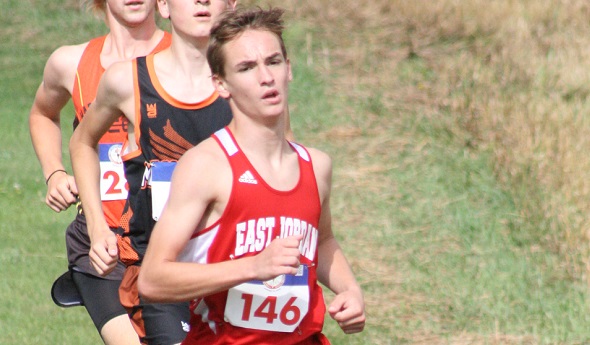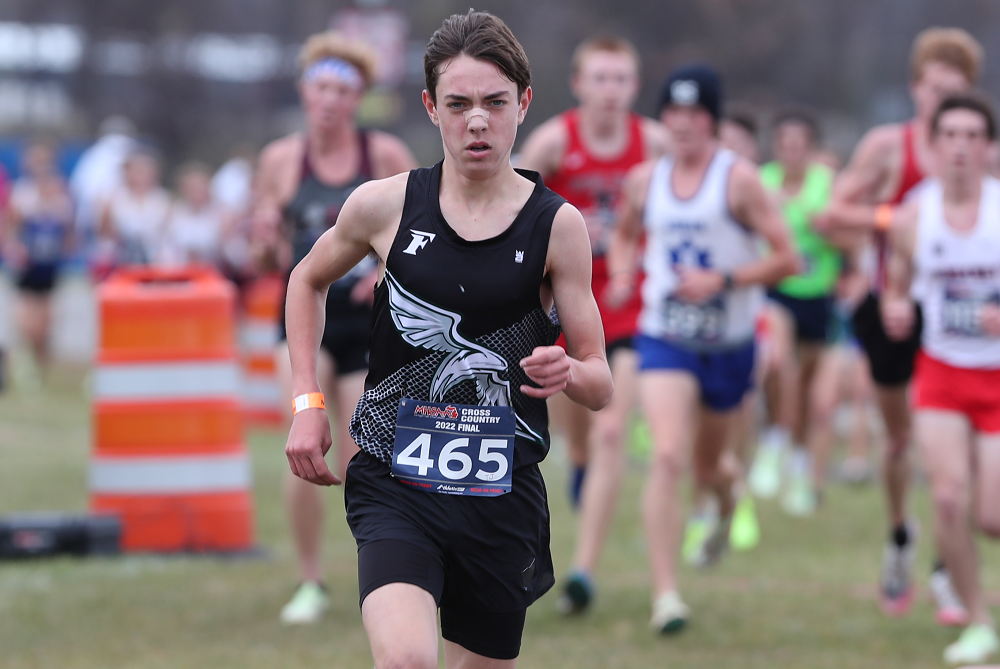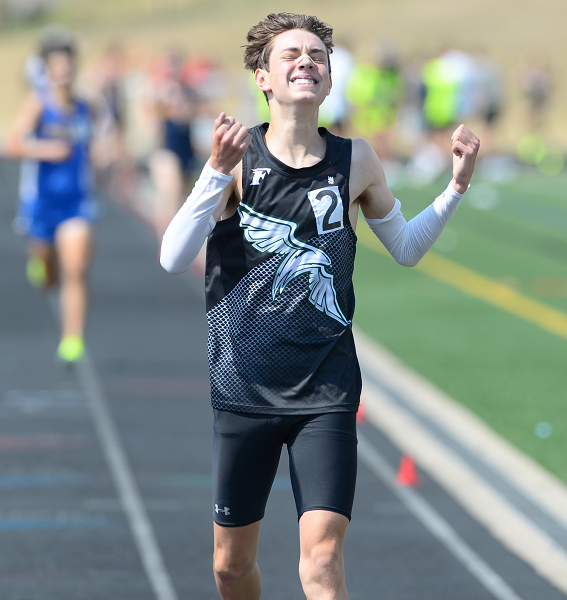
Seniors Setting Pace for East Jordan Run
August 23, 2019
By Chris Dobrowolski
Special for Second Half
EAST JORDAN — Matt Peterson says he couldn’t have asked for a better group than the one he has this year making up his boys cross country team at East Jordan.
 Peterson also couldn’t have asked for more experience than the Red Devils bring into the 2019 season.
Peterson also couldn’t have asked for more experience than the Red Devils bring into the 2019 season.
East Jordan returns its top five runners from a team that finished third at the Lower Peninsula Division 4 Finals last year, all part of a senior class that has made a major impact for the Red Devils over the past three years.
“Not only are they hard workers and pretty talented runners,” said Peterson, “they’re all just real high-quality kids. They truly lift up everyone around them, not just on our team but in the school. They’re just positive, positive kids, every one of them. I feel super lucky to have them.”
Ethan Nachazel, Aaron Nachazel, Ben Hardy, Alex Schlueter and Caleb Carson are the quintet the Red Devils have leaned on primarily since they entered high school. They led East Jordan to a pair of top-10 finishes in 2017 and 2018 after snapping a 16-year Finals drought for a program that won titles in 1998 and 2000.
The seniors are the best of friends, spending countless hours together at sleepovers or for training runs. Their relationships have forged a bond of cohesiveness between the veteran leaders of the team and the squad in general.
“We’ve all grown up together since kindergarten, and we know each other pretty well,” said Ethan Nachazel. “We keep each other accountable. It’s just nice to know you have all these guys keeping each other together. It’s very important because not only do you work better together and improve quicker, but you also bond way quicker together than you would just by being at practice.”
By all accounts Ethan Nachazel is the Red Devils’ top runner, finishing a team-best 14th overall at last year’s Final and 28th overall to pace East Jordan in 2017. But after that, the pecking order can change from meet to meet and year to year. Hardy, for example, was East Jordan’s fourth counter at the 2017 Final, but improved his time by 1 minute, 14 seconds at last season’s meet to take 15th overall, finishing alongside Ethan Nachazel.
“Ethan has been predominately our first guy, except for one or two meets last year,” said Peterson. “I expect the top five or six to probably move around a bit.”
The Red Devils’ seniors, a collection that has a team-first mindset, have no qualms about who finishes in what order. They’ve set a standard amongst themselves to work toward the ultimate goal — team success.
“It’s fun,” said Nachazel. “We all take the lead during workouts, and we all try to share as much as we can. I think we all contribute just as much. We share the wealth equally.”
“I don’t think it would matter if someone ran well and they were normally the second guy and became the fourth guy because someone knocked them out of their place, but it helped the team,” said Peterson. “They would be OK with that.”
From serious to silly, the Red Devils’ seniors have diverse personalities, but that seems to work toward their advantage in creating good team chemistry, too.
“I think that’s a good mix to have,” said Peterson. “You need to have the serious kids on the team, and you need to have the kids who will provide a little levity and help kids relax once in a while.”
East Jordan’s coach describes Ethan Nachazel as the most serious, while Schlueter brings a humorous side to the equation.
“I think it’s very important to be light-hearted outside of practice and in practice too,” said Schlueter. “Just kind of get everyone’s spirits up. If we were too focused for too long we would just run out of that mental energy at the end of the season, and we don’t want that so I just keep everything light. But when it comes to race day, when we get on that line, it’s just focus.”
The Red Devils have depth outside of their seniors as well. Peterson sees junior Phillip Nemecek and sophomore Caleb Ziebarth as having the capabilities to contribute and perhaps even crack the top five on the team.
Ultimately, the Red Devils are hoping it all leads to another trip to the Finals. There’s no doubting East Jordan is armed with the experience and the ability.
“I think the key for this team, but I could say for any cross country team, is us having a small 1-to-5 gap,” said Peterson. “If we’re fortunate enough to get to the state meet again, I think the team that can pack it up the most and have the smallest gap is going to have the potential to be really successful.”
No matter what happens, though, the Red Devils know the friendships and connections they’ve formed over the years are, and will remain, strong.
“Cross country is one of the best things I’ve ever done,” said Schlueter. “I’ve just met so many people that I love. I’ve fallen in love with these guys. I couldn’t ask for anyone better.”
 Chris Dobrowolski has covered northern Lower Peninsula sports since 1999 at the Ogemaw County Herald, Alpena News, Traverse City Record-Eagle and currently as sports editor at the Antrim Kalkaska Review since 2016. He can be reached at [email protected] with story ideas for Manistee, Wexford, Missaukee, Roscommon, Ogemaw, Iosco, Alcona, Oscoda, Crawford, Kalkaska, Grand Traverse, Benzie, Leelanau, Antrim, Otsego, Montmorency, Alpena, Presque Isle, Cheboygan, Charlevoix and Emmet counties.
Chris Dobrowolski has covered northern Lower Peninsula sports since 1999 at the Ogemaw County Herald, Alpena News, Traverse City Record-Eagle and currently as sports editor at the Antrim Kalkaska Review since 2016. He can be reached at [email protected] with story ideas for Manistee, Wexford, Missaukee, Roscommon, Ogemaw, Iosco, Alcona, Oscoda, Crawford, Kalkaska, Grand Traverse, Benzie, Leelanau, Antrim, Otsego, Montmorency, Alpena, Presque Isle, Cheboygan, Charlevoix and Emmet counties.
PHOTO: East Jordan’s Ethan Nachazel leads a pack during Saturday’s Ryan Shay Memorial Invitational. (Photo by Chris Dobrowolski.)

Freeland's Hansen Not Focused on Joining All-Time Greats - But On His Way
By
Paul Costanzo
Special for MHSAA.com
September 29, 2023
The goal written on Matt Kaczor’s Post-It Note was sub-15 minutes, 15 seconds. That’s what the Freeland cross country coach was hoping for from star runner TJ Hansen during his junior season.
 Kaczor tore it up after seeing Hansen run a single race this fall.
Kaczor tore it up after seeing Hansen run a single race this fall.
“Knowing what he did over the summer and where he was at, seeing what his 1,600 (meter) and his mile got down to, I had a feeling he could get under 15:30 quickly,” Kaczor said. “After the first race, I looked at my assistant and was like, ‘I’ve gotta rip up that Post-It Note. I don’t think our goal is on the level of where he’s at right now.’ At first, it was break 15:15. Once I saw him race at the Under the Lights (on Aug. 18 at St. Johns), I was like, ‘Yeah, he’s going sub 15.’”
Hansen ran 15:39.6 in that first race, and on Sept. 7, in Shepherd, he ran 15:13.9 to meet the goal written on the now-shredded Post-It Note.
This past Saturday, he ran 15:03.7 at the Cadillac Veterans Serving Veterans Invitational. It’s the fastest time recorded in Michigan this year, and a signal that Kaczor might be filling out a new Post-It Note before the season is out.
“The sub-15 barrier, that’s been something on my mind for a while,” Hansen said. “Now that I’m edging closer and closer to that, it’s been exciting. With how heavy my training has been, I wouldn’t expect (to have run this fast this early). Being able to run the times I am really paints the picture for what’s ahead.”
Hansen came into the season already regarded as one of the elite distance runners in the state. He won the 3,200 meters at the MHSAA Lower Peninsula Division 2 Track & Field Finals this past spring. He’s also finished all-state (12th and fifth, respectively) the past two seasons at the LPD2 Cross Country Finals.
His current trajectory, however, would put his name near some of the state’s all-time greats. But that’s not something Hansen is focusing on.
“I really don’t like to compare myself to others,” he said. “I don’t focus on that. I try to be the best TJ Hansen that I can be. The best version of myself.”
Focusing on himself is almost necessary for Hansen, as he’s spending a lot of time during his races running by himself.
At each of the big events Freeland has run in this season, Hansen has finished at least 20 seconds ahead of his nearest competitor. That includes all divisions of the Duane Raffin Festival of Races in Holly.
In Cadillac, where Hansen ran his current best time, he was a full minute ahead of the rest of the field.
 “He’s just a special athlete,” Kaczor said. “I can’t see Freeland having someone like this in a while. He’s a generational talent. What’s crazy is, I had the school record when he was a freshman. He and Braden (Honsinger) broke it last year. But TJ has now dropped that school record (set in 1998) by almost a minute.”
“He’s just a special athlete,” Kaczor said. “I can’t see Freeland having someone like this in a while. He’s a generational talent. What’s crazy is, I had the school record when he was a freshman. He and Braden (Honsinger) broke it last year. But TJ has now dropped that school record (set in 1998) by almost a minute.”
Hansen’s achievements have already put him on a path to run at the next level, which is something of a family tradition.
His older sisters Peyton and Kiera are track & field athletes at Wayne State and Eastern Michigan, respectively. Their parents, Tim and Pam, were track & field stars at Central Michigan.
TJ has drawn the attention of coaches around the country, including from Michigan, Michigan State, Wisconsin, Tennessee and Colorado.
Having family members who know the process is a help for Hansen, and he said they’ve all been good about allowing him to choose his own path, whatever that may be.
“He’s from a good family that knows how to work and knows how to get things done,” Kaczor said. “He knows that if he puts in the work, he’s going to be at a good spot.”
While Hansen admits it can be a bit overwhelming, he’s using it as motivation to run faster and continue to put his name out there.
Also serving as motivation is 2022 Division 2 champion Connell Alford of Chelsea. Alford is among the elite group of runners in Michigan who have broken the 15-minute mark, doing it twice a year ago.
He currently has the state’s second-best time behind Hansen’s this year, running 15:09.1 at the MSU Invitational on Sept. 15.
“Whenever I see him drop a time, my main goal is to run faster,” Hansen said. “Whenever I see him run a good time, that motivates me to work hard.”
The two won’t see each other until the MHSAA Finals on Nov. 4 at Michigan International Speedway. It’s an opportunity Hansen is excited for, as it’s a chance to race and be pushed toward the lofty goals he’s set for himself. Kaczor is excited about it, too, even if it might mean having to replenish his supply of Post-Its.
“We don’t talk about winning the state title; we talk about making sure that we have great races on those days,” Kaczor said. “We can’t control how somebody else runs. It’s a matter of can we, if the weather is right and the course is in good condition, can we be one of the few guys that has run in the 14s on that course? That’s the goal. Put yourself in some great categories with those upper echelons and the greats of all-time.”
 Paul Costanzo served as a sportswriter at The Port Huron Times Herald from 2006-15, including three years as lead sportswriter, and prior to that as sports editor at the Hillsdale Daily News from 2005-06. He can be reached at [email protected] with story ideas for Genesee, Lapeer, St. Clair, Sanilac, Huron, Tuscola, Saginaw, Bay, Arenac, Midland and Gladwin counties.
Paul Costanzo served as a sportswriter at The Port Huron Times Herald from 2006-15, including three years as lead sportswriter, and prior to that as sports editor at the Hillsdale Daily News from 2005-06. He can be reached at [email protected] with story ideas for Genesee, Lapeer, St. Clair, Sanilac, Huron, Tuscola, Saginaw, Bay, Arenac, Midland and Gladwin counties.
PHOTOS (Top) Freeland's TJ Hansen leads a pack during last season's LPD2 Final at Michigan International Speedway. (Middle) Hansen enjoys a moment of exhilaration after winning the 3,200 this spring at the LPD2 Finals at Ada Forest Hills Eastern. (Top photo by Carter Sherline/Run Michigan; middle photo by Dave McCauley/Run Michigan.)

